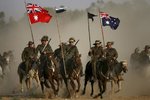Emac44
Staff Sergeant
Fall of Beersheba to the Allies 31st October 1917. Infamous charge by Australian Lighthorse. Successful attack on Beersheba and finally a successful conclusion to the 3rd Battles of Gaza by British and Commonwealth Forces, Consided a turning point to the Battles for Gaza
Beersheba 31 October 1917
Beersheba 31 October 1917


